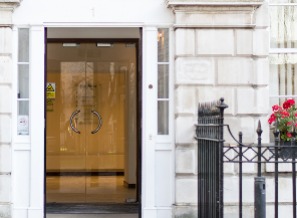
- Minimally invasive, day case Hammertoe removal surgery
- No crutches, no downtime, walk out of the clinic on the day
- Performed at Fitzroy Hospital in Central London
- 0% Finance Available
Hammertoe
Day case Hammertoe treatment keyhole (Minimally invasive) surgery with no metal fixtures and minimal downtime.
What is hammertoe?
Hammer toe is a deformity of the foot that can cause your toe or toes to bend and curl downwards instead of lying flat and pointing forward. Hammertoe can affect any toe on the foot although it is most common on the second or third toes. Usually, a hammertoe forms over time but it can also be present from birth.
Hammertoe can cause discomfort when walking, pain when you try to flex or wiggle your toes, corns and calluses and can make finding shoes that are comfortable to wear a challenge.
What causes a hammer toe?
Hammer toe can be caused by:
- Pressure from a bunion
- Wearing ill-fitting shoes
- Arthritis
- High foot arch
- Toe injury
- Tight ligaments or tendons in the foot
How is hammertoe treated?
For mild hammertoe where the raised joint in your toe remains flexible, the condition can often be fixed without the need for surgery. Non-surgical hammertoe treatments include physiotherapy, wearing wider footwear, orthotic devices and toe splints.
However in many cases, nonsurgical treatments may not work – especially for more severe cases of hammertoe where the affected toe is no longer flexible
Surgical hammertoe treatment traditionally involves a procedure known as Arthroplasty or Arthrodesis. The joint of the toe is removed and a wire is placed into the toe to keep it straight whilst it heals. After 4-6 weeks the wire will need to be removed and you can start to return to work and exercise. Many put off this procedure due to the downtime required and the need for wires.
Here at The Private Clinic, we offer an exclusive minimally invasive surgical technique to effectively treat the signs and symptoms of hammertoe with our Orthopaedic Consultant Surgeon, Mr Andrea Bianchi.
Hammertoe or toe straightening surgery uses a mini-invasive percutaneous keyhole technique that is performed under local anaesthetic. The treatment does not require the use of any fixation devices such as metal wires and patients can walk immediately with no crutches and get back to their everyday activities with minimal downtime and a lot quicker than traditional hammertoe surgery.
Minimally invasive hammertoe surgery is exclusively available at The Private Clinic Group with Consultant Orthopaedic Surgeon, Mr Andrea Bianchi founder of PBS, the team who developed the percutaneous bunion surgery in 1996 and has performed over 50,000 surgeries since.
Consultations are available in London Harley Street and Bournemouth.
The Private Clinic have collaborated with Chrysalis Finance to offer 0% finance for our patients.*
*Acceptance is subject to status. Terms and conditions apply.
The Procedure
How does Hammertoe surgery work?
The Hammertoe and toe straightening surgery procedure that we offer was developed by Mr Andrea Bianchi and his team who will be performing the treatment at our hospital in central London.
The minimally invasive keyhole procedure is performed under precision using continuous x-ray imaging known as a fluoroscopy. The surgeon will then use surgical dental burrs to modify the bones of the foot and correct the deformity which are inserted via very small 2-3mm incisions.
Once the bones have been realigned, the fractures are left free without any fixative devices such as screws or pins. The foot is then allowed to heal in a more natural position which results in better comfort and functionality post-procedure as the foot is healing according to the patient’s load-bearing needs and not to a pre-set standard that may not be right for the patient.
Following the procedure, the foot will be bandaged and taped using a specialised bandaging technique which allows the physiological healing process to spontaneously restructure the foot and avoid any additional stress caused by arbitrary immobilisation. You will also be provided with a specialised orthopaedic shoe to wear and you will be encouraged to walk on the foot before leaving the hospital.
What is the downtime following hammertoe surgery?
The downtime following hammertoe and toe straightening surgery is minimal. Patients will be able to walk without the use of crutches almost immediately post-surgery. It is advised that you take care to rest the foot when possible, but the majority of patients can return to work and their everyday activities after 1-2 days. Patients are required to wear the orthopaedic boot until they return for their follow-up appointment round 25 days post-treatment.
What is the recovery like after Hammertoe surgery?
Patients will need to return to the clinic around 25 days following hammertoe and toe straightening or surgery where the bandaging on the foot will be changed and reduced. In most cases, patients are also able to start wearing comfortable shoes again if given the go-ahead from the surgeon. A follow-up x-ray will be arranged 45 days post-procedure to assess the results.
Hammertoe consultations are Available in these Clinics
FAQs
Choosing to have surgery or not is a personal decision that only you can make.
If your hammertoe is causing you pain and discomfort, then this is a good reason to consider surgery.
To find out more about hammertoe or toe straightening surgery and to get the opinion from our resident Consultant Orthopaedic Surgeon then we recommend booking a no-obligation consultation where you will be able to discuss your concerns to help you make a more informed decision.
Hammertoe is a progressive condition and will unlikely go away on its own. Some cases of hammertoe progress and worsen quicker than others so it will vary from person to person.
Yes, patients will be able to walk without the need for crutches almost immediately after hammertoe or toe straightening surgery.
Hammertoe or toe straightening surgery is performed under local anaesthetic so you should not feel any pain during the procedure. Some pain or discomfort may be felt once the local anaesthetic has worn off, but this can be managed with painkillers and should only last for the initial days following surgery.
Surgery is the best way to permanently fix a hammertoe and will also provide the best results.
Book a consultation
Begin your treatment pathway by booking a consultation with our expert Consultant Orthopaedic Surgeon.
Consultations are available in London Harley Street or Bournemouth.







